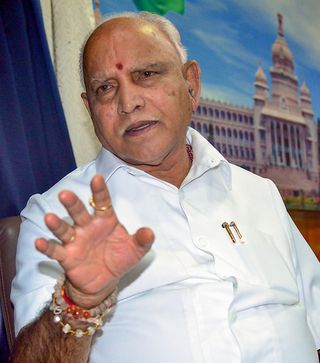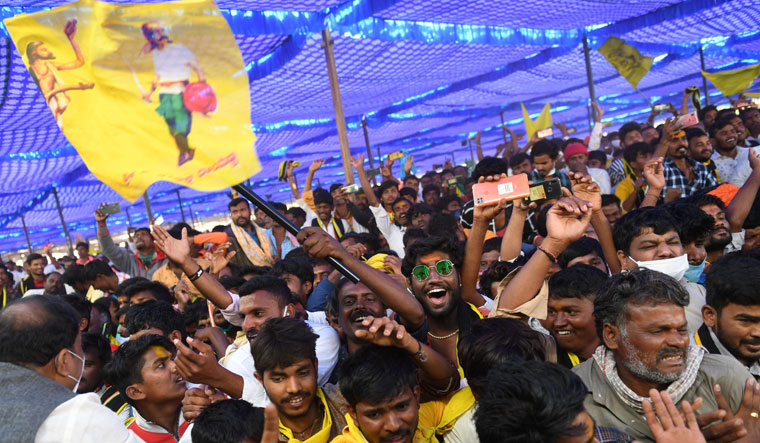The Panchamasalis, a dominant sub-sect of the Veerashaiva-Lingayat community, are on a 450km padyatra to Bengaluru from Koodalasangama in Bagalkot, the resting place of Basavanna, the founder of Lingayatism. Their demand—a move from 3B (which assures 5 per cent reservation) to 2A category (15 per cent) within the state’s OBC quota.
At present, Karnataka has a 15 per cent quota for scheduled castes (101 castes), 3 per cent for scheduled tribes (50 groups) and 32 per cent for OBCs (207 castes). There are five sub-categories within the OBCs. The numerically strong Panchamasalis currently share their 5 per cent reservation with various other caste groups, besides Marathas, Jains and Christians.
“The Panchamasalis are farmers and a majority are socially, economically and educationally backward and need reservation under 2A,” said padyatra leader Basava Jaya Mrutyunjaya Swami of Panchamasali Peetha in Koodalasangama.
The march has embarrassed Chief Minister B.S. Yediyurappa, the tallest Lingayat leader in the state, at a time when the ruling BJP is searching for his political successor. It has been only a few years since the community—encouraged by Congress ministers M.B. Patil and Vinay Kulkarni—had demanded a minority religion tag for itself. While that movement seems to have fizzled out after the Congress lost 14 seats in the Lingayat belt (Mumbai-Karnataka region) in the assembly elections, Yediyurappa is finding it difficult to hold on to the Veerashaiva-Lingayat community, a force in over 100 assembly constituencies.
In November, Yediyurappa had pushed for Veerashaiva-Lingayats to be included in the Central OBC list; this would have given them a share in the 27 per cent quota in Central government jobs and educational institutions. However, the party’s central leaders reportedly killed the move. Yediyurappa then hastily set up a Veerashaiva-Lingayat Development Corporation with a corpus of Rs500 crore to pacify the community.
In 1996, Prime Minister H.D. Deve Gowda had used his political clout to include the Vokkaligas, a landholding community, in the Central OBC list. Decades later, his Janata Dal (Secular) still reaps political gains.
“The Lingayat community has 99 sub-sects, but the Panchamasali sub-sect accounts for 80 per cent, with a population of nearly 85 lakh,” said Swami Vachanananda, pontiff of Panchamasali Jagadguru Peetha, Harihara. “The community has had great leaders like Akka Mahadevi, Rani Keladi Chennamma, Rani Belawadi Mallamma and, of course, chief ministers S. Nijalingappa and J.H. Patel. [But] it lacks adequate political representation.”
The stakes are high for Yediyurappa. The Panchamasali pontiffs who used to back Yediyurappa—who belongs to Ganiga (oil-pressers) sub-sect—are now rallying behind Panchamasali leaders and BJP ministers C.C. Patil and Murugesh Nirani, and Yediyurappa’s bitter critic and Vijayapura MLA Basanagouda Patil Yatnal.
The chief minister is visibly stressed. Recently, when Yatnal confronted Yediyurappa on the reservation issue in the assembly, the latter retorted: “The BJP is a national party. This decision should be taken in consultation with central leaders. I do not have the powers to decide. Yatnal is free to take any of the 25 BJP MPs to meet the central leadership.”
The statement miffed Panchamasali seers, who told him to either fulfil the demand or resign. “Let the prime minister, [BJP president J.P.] Nadda or [Union home minister] Amit Shah give Yediyurappa an honourable exit and install a capable Lingayat leader in his place,” said Jaya Mrutyunjaya Swami.
Within hours, Yediyurappa retracted his statement and ordered the Karnataka backward classes commission to prepare a report on the inclusion of Panchamasalis in the 2A category. The community has urged the chief minister to place the demand before the cabinet to avoid further delay. If the Panchamasalis have their way, the 102 castes under 2A would naturally be upset.
The other challenge for Yediyurappa is the Kuruba community’s demand to be included in the scheduled tribes category. On February 4, a 21-day-long march led by Sri Niranjananandapuri Swamiji of Kanaka Guru Peetha from Kaginele, the birthplace of 16th century saint-poet and Kuruba icon Kanaka Dasa, culminated in Bengaluru. The march has united Kuruba leaders across parties, and has put pressure on the BJP leaders. Several party leaders, including four Kuruba ministers, have backed the demand.
The Kurubas’ demand has also rankled the community’s top leader in the state—former chief minister Siddaramaiah. He skipped a large Kuruba convention in Bengaluru on February 7; he reportedly suspects the Rashtriya Swayamsevak Sangh of backing the agitation to dwarf him politically. “I support the demand,” he said, and dared fellow Kuruba leader K.S. Eshwarappa to meet Prime Minister Narendra Modi and Amit Shah to secure the scheduled tribe tag instead of staging protests.
Siddaramaiah, who had come to power thanks to a coalition of minorities, backward classes and dalits—together called Ahinda—cannot be seen as favouring just the Kurubas. On the other hand, being a leader of the community, he cannot deny support to the Kuruba cause.
In 2017, Eshwarappa, who hails from Yediyurappa’s Shivamogga district, had floated an organisation called Sangolli Rayanna Brigade to consolidate the backward class votes. The Brigade had invoked the Kuruba icon Rayanna, an 18th century warrior, to counter Siddaramaiah’s Ahinda politics. Siddaramaiah lost the 2018 assembly elections.
The current agitation has united caste leaders across parties whom Siddaramaiah had overshadowed for long. The movement promises to bring in a new leadership and perhaps carve out a new political constituency by breaking the Ahinda coalition.
The Kurubas, the third largest community after Veerashaiva-Lingayats and Vokkaligas, are under the 2A category of OBC reservation. The scheduled tribe tag would give them reservation in education and jobs, and also political representation; there are 15 reserved assembly and two Parliament constituencies in the state. Moreover, Valmiki leader and state Social Welfare Minister B. Sriramulu is leading a parallel movement to increase the scheduled tribes quota from the current 3 per cent to 7.5 per cent, proportional to their population in the state.
“An anthropological study is unnecessary as it is needed only in cases where a community is to be added to the SC or ST list for the first time,” said Eshwaranandapuri Swami, seer of the Hosdurg Mutt. “Our demand is that Kuruba be recognised as equivalent to Kuruman, which already figures in the ST list. In fact, Kuruba is identified as Kuruman in Kerala, Kurumbar in Tamil Nadu, Gonda in Hyderabad-Karnataka region and Jenu Kuruba and Kadu Kuruba in Mysore region. They are all in the ST list in some states and a few districts in Karnataka like Bidar, Kalaburagi, Yadgir and Kodagu. We want all Kuruba names to be brought under the ST tag.”
He added that Siddaramaiah’s earlier recommendations to the Centre had not been accepted.
The Panchamasali and Kuruba agitation aside, both scheduled castes and scheduled tribes have been seeking to increase their quotas based on their population in the state. The Maadigas, a marginalised community of “untouchables” within the scheduled castes, are also seeking sub-quota within the reservation as the dominant castes have cornered the reservation benefits.
A major hindrance to accepting these demands is the 50 per cent cap on reservation imposed by the 1992 judgment of the Supreme Court. The Justice H.N. Nagamohan Das Commission, which the previous JD(S)-Congress government had constituted, has recommended a hike in quota for scheduled castes from 15 per cent to 17 per cent and for scheduled tribes from 3 per cent to 7 per cent.
The Siddaramaiah government, in 2015, had carried out a caste census (socio-economic survey), a first since 1931, at a cost of Rs158 crore. Interestingly, it has not been made public by subsequent governments as it reportedly debunks the claims of some dominant communities.
The caste cauldron could pose a major hurdle to Yediyurappa winning his target of 150 of the 224 seats in the 2023 assembly elections




